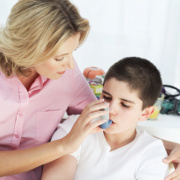 Photo: Getty Images
Photo: Getty Images
When we leave on a field trip, our school nurse packs a “medicine bag” full of student prescriptions. Without fail, our med bag contains several asthma inhalers. According to the Centers for Disease Control and Prevention, nearly 10 percent of kids suffer from asthma. When the lungs are compromised by asthma, air can not travel to the airways as it should. In its child-friendly pamphlet, the CDC used this analogy to help kids understand their illness:
The tubes that take air to your lungs get too tight (like a pinched straw) and this makes it hard for you to breathe.
When diagnosing asthma, your child’s doctor will ask about any family history of the condition. Let the doctor know if your child coughs a lot, especially during the night. The physician will want to know if your child’s breathing problems are more difficult after strenuous activity or during allergy season. A spirometry, or lung function test, may also be performed to measure the amount of air exhaled after a deep breath.
Triggers for an asthma attack or worsening of symptoms include allergens like dust and mold, pollution, cigarette smoke, pet dander, and droppings from cockroaches. Overcast days with high humidity can also make breathing more difficult in the asthmatic. Since strenuous exercise during PE may trigger an attack, your child’s doctor could recommend carrying the inhaler in a pocket during gym class. During an asthma attack, your child can experience wheezing, shortness of breath, and a tight feeling in the chest.
Asthma medicine is prescribed for both quick relief or “rescue,” and long-term control. Rescue medicines inhaled through a bronchodilator, like an inhaler or nebulizer, immediately relieve symptoms during an asthma attack. The meds relax the tightened muscles in the airways and the attack ends. While this relief is effective and dramatic, it is only temporary. Medicines that provide long-term control of asthma are taken on a regular basis to help prevent symptoms.
A doctor-recommended personalized action plan to control asthma is also an important part of helping a child cope with his or her condition. The action plan notes medications and when they should be administered as well as what to do during worsening symptoms or an attack. Ideally, this action plan can also be given to your child’s day care provider or school nurse. While asthma can’t be cured, if can be managed and many report that symptoms lessen as the child grows older.
Click on the link below for a sample action plan. Remember that asthma action plans are developed with guidance from your doctor. http://www.nhlbi.nih.gov/health/public/lung/asthma/asthma_actplan.pdf
Sources:
http://www.cdc.gov/asthma/default.htm
http://www.epa.gov/asthma/pdfs/ll_asthma_brochure.pdf
(CDC patient pamphlet)
http://www.cdc.gov/asthma/pdfs/kids_fast_facts.pdf
(CDC kid friendly pamphlet)
Reviewed June 3, 2011
Edited by Alison Stanton






Add a CommentComments
There are no comments yet. Be the first one and get the conversation started!